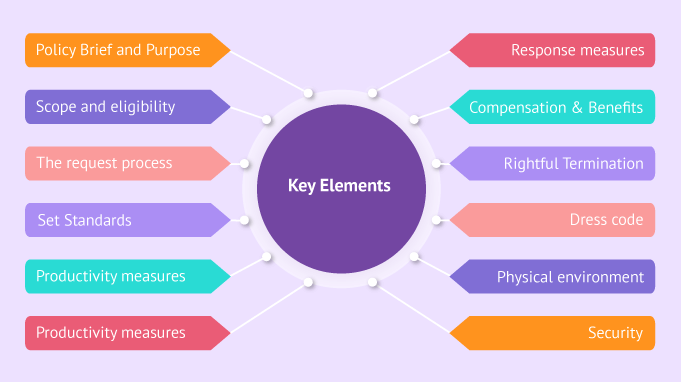Work From Home Policy: A How-To Guide For Managers in 2024
Work from home(WFH) is a growing trend in today’s work environment, in which employees can easily plug-in from just anywhere they are. A work from home policy is nothing but an agreement between the employer and the employees who prefer to have the work from home privileges. The policy defines the expectations, responsibilities, the eligibility and the other work from home guidelines. In short, it ensures that all employees understand what is required of them when they choose to work from home.
While some companies have a regular option of remote working, others take it up during emergencies. Like, look at the current condition. Coronavirus has sparked a revolution in the WFH scenario. As the terror of Covid-19 continues to spread, many employers have already considered the home office set up quite seriously, to avoid reduced productivity. Top companies like Google and Microsoft have arranged for enhanced teleconferencing tools to make work from home more comfortable than ever.
Whatever be the circumstances, companies need a defined work from home policy to make it work. The work from home policy can be tailored as per the company’s needs and requirements. In the due course it can be modified according to the company’s specific values.
The Key Elements Of A Work From Home Policy
1.Policy Brief and Purpose
Mention clearly what the intent of your work from home policy is, and what you are aiming to achieve by providing job opportunities from home. Communicate the importance of the policy as well as how it will be implemented going forward. It should improve the overall employee value proposition, maximizing the work experience of your team members.
2. Scope and eligibility
Specify which positions are available for remote work within the organization considering client-facing responsibilities, software limitations, and remote work security risks. It will help in reducing excessive or unnecessary work from home requests.
Also, clarify who will accept work-from-home applications, and on what basis each application will be assessed. Will HR supervise the process, or will the individual manager review it?
However, they should consider the following elements before deciding 'who' can work from home:
- Does the nature of the employee's job allow them to work from home?
- Are there any security or privacy issues?
- Will communication with the remote employees be difficult?
- Do they have the required software or equipment installed at home?
- What are the conditions in the employee's place of work?
Apart from these, the work from home policy should also mention 'when' the employees can work from home. Generally, they can work from home:
- On certain occasions.
- Full time.
- Every day, by dividing their time between being at the physical workplace and their remote workstation.
3. The request process
The entire procedure of requesting WFH should be laid out clearly- should employees make a formal request, or do they need to register themselves or have a discussion with their manager? Provide a gradual rundown of what they need to do to have the right to WFH.
4. Attendance and Availability Standards
The availability expectations of the remote workers must be outlined in work from home policy. It can be a challenge to bring your people to the desk and get their input right on time. To avoid this problem, you must set standards around when and how your remote workers should be available.
5. Productivity measures
The policy should also specify how remote workers' productivity will be measured. It can evaluate in a variety of ways, like depending on the time spent on the project, number of cases handled, amount of customer interactions, and more. companies need to decide how they want their remote workers to be assessed.
6. Equipment and Tech support
It needs to state what equipment and tech support will be offered to their remote employees. If the company expects them to use their own laptops, for example, it must be mentioned in the policy. It should also outline what they are supposed to do when having technical difficulties and have an action plan for that as well.
7. Response measures
The policy should define whether or not the remote workers are expected to respond to the manager or a colleague immediately. Also, it should streamline the communication channels, promoting a healthy bonding between workers and supervisors.
8. Compensation and Benefits
If working from home has any effect on the compensation and benefits of the employees, the policy should mention it.
9. Rightful Termination
Many employers feel uncomfortable providing the home office opportunities because of the lack of face to face communications. However, the work from home policy should contain the fact that no employee will be fired on the grounds of operating remotely.
10. Dress code
While working from home, employees still have to be in touch with colleagues, clients, or business partners via Video conferencing. For this condition, a note about the suitable dress code while remote working is reasonable.
11. Physical environment
If you, as an employer, prefer your remote workers to work in a particular physical environment, don't forget to put in the policy. Many companies tend to test and approve the same before working remotely.
12. Security
All the specific requests regarding official security and client confidentiality must be stated in the policy. For example, if you don't want your remote worker to use a public WiFi, then that should be mentioned for employees to be cautious while working from a public place.

Ten Benefits Of A Work From Home Policy And Reasons Why We Need It Right Now
Let’s first understand from the employers' point of view.
1. No Or A Lot Less Office Space
Office space rental is a significant expense for most small and medium-sized companies. Besides, maintenance and repairs cost extra. WFH allows you to save the money on office space which can be utilised better in so many other things.
2. Hire The Best, Globally
No matter where they are based from, you can hire the best talent to work with. Technology and the internet are making it easier to hunt, review and hire great candidates around the world. There are numerous tools that professional recruiters can use to explore. LinkedIn Recruiter, Entelo, SmartRecruiters and Glassdoor top the list of the most essential, modern tools for recruiters.
And there is more to it. Your remote employees can promote your brand by just sharing their sense of pride in being associated with you. It gives you a fantastic opportunity to enhance your image. You can also get an insight into their local markets.
3. Higher Retention
Work-from-home opportunities play a significant role in the decision of an employee to quit a job, and companies that offer it see a significantly less turnover than those who do not. There are two main reasons why. First, most remote workers stay happily engaged and are less likely to search for a different job with other companies. Second, they experience a better work-life balance and do not experience burnout easily.
4. Lesser Absenteeism
Working from home is the best viable option for decreasing employee absenteeism. It allows your employees to take care of themselves and still get the work done. In simple terms, working from home gives them the flexibility to set their own routine. It enables them to take care of their sick kids or run errands without taking a full day leave from office.
5. Longer Working Hours
People who WFH waste less time commuting. They are at your office right when they wake up. It saves money, energy and acts as a great morale booster. Thus the time on commuting can be used for some real job, making work hours longer than usual.
Now, let us look from the employee’s point of view.
6. Flexible Work Schedule
A work from home policy allows you to adjust the days and hours of work. Employees feel no rush, take breaks anytime they want and can manage a perfect work-life balance. This factor plays a significant role in the lives of parents who have young kids. It’s the best way to balance your family’s need for your income with your necessities to spend time with them.
7. Increased Productivity
If you think that the coronavirus will affect your productivity and business, you are probably wrong. This past survey result will surely amaze you.
Airtasker, a gig economy platform, surveyed 1004 full-time employees about their daily productivity. It found that office workers reported staying idle for about 37 minutes a day, excluding lunch and regular breaks. Whereas, employees who WFH are more productive, who spend only 27 minutes per day being unproductive.
The reasons for maximized productivity at work from home are many. Firstly, employees can command working conditions. Like say, they can keep the room temperature as they like, some might like the music playing while others might want to work sitting in the garden. Such advantages are endless in work from home policy.
8. No More Crowds And Traffic
Peak hour traffic congestion is the biggest challenge that employees face every day. Indeed WFH is the only practical solution to deal with it. It also gets cheaper as you don’t have to worry about your travel expenses anymore.
9. Reduced Stress Level
At your home office, there are hardly any office distractions. There is no annoying co-workers, no office politics, and no mental pressure. Under this condition, you are free to be as creative as you can become. Also, you can customise your own workplace setup. One study found that just adding plants to your workplace could reduce work stress and negative feelings by 30-60 per cent.
10. Healthier Body
WFH allows you to save some extra time each day. That’s when you can start taking some extra care for your health. You can catch some extra sleep or spend them on physical activities or meditations. By sitting less, you can get a better posture and avoid back pain. You will also prevent the junks from your office canteen and start cooking healthy lunch! All these will lead you to a better physical and mental health which will also improve your daily life.
Difference and Similarities- Work From Home, Remote Work, Telecommuting
The culture of flexible work has seen quite a rise in the past decade. Whereas the previous workforce sought stability in their 9-5 jobs, the new workforce (consisting mostly of millennials) consider work-life balance over everything else when working for an organization.
Businesses of today are all competing against each other to hire the top talents. If you want to attract a more diverse and the top talents in the game, then having some sort of flexible work option would be one of the best benefits to attract and ultimately retain the best employees.
In the era of digital advancements, implementing a work-life balance schedule is nothing new. Among the more popular options to juggle both personal life and work life, the newer generational workforce is leaning towards flexible work options. Among these options, the more popular ones seem to be of- WFH, remote work, and telecommuting.
Although principally they might sound a lot similar and their end goal is the same, however, there are quite a few areas where these three flexible work options differ from each other.
Let us have a detailed look over the similarities and differences among all the three flexible work arrangements. This will help you be a better judge of which one of these would be the best suited for your organization.
Definitions Of Remote Work, Work From Home, Telecommuting
Remote Work
Remote work implies that a person is employed in order to work from any location that he/she desires without having to ever come to the onsite office space.
Work From Home
WFH is usually a work arrangement where the employee can work from his/her home for a period of time.
Telecommuting
Telecommuting or telework denotes an employee who works from a remote location but might have to come into the onsite office space some time or the other.
Similarities Of Remote Work, Work From Home, Telecommuting
1. Flexible Work
Remote work, WFH, and Telecommuting are flexible work options that allow employees to have better work-life balance. A good work-life balance will only result in happier and more productive employees. Any of these three work arrangements is an incredible benefit to offer to employees.
2. Use Of Communication Tools
Seeing that all three work arrangements are mainly based on working from a location that is not the office space, there is an inherent need for proper communication tools. To work effectively with the rest of the team, flexible work employees need to use superior communication tools to stay in the loop.
3. Managers
Despite working from other locations, such employees are still liable to report to a certain manager. As with other office workers, even flexible work employees will have to take their instructions and work under their managers. However, this doesn’t imply that a manager will micromanage these flexible workers. In order to build an honest and transparent workflow, managers should seek to measure performance standards of employees through something tangible such as goal-setting.
4. The Need For Recognition
No matter what sort of work arrangement an employee has, but as long he/she is employed by your company their satisfaction will largely affect the business outputs as well.
That is why it is extremely necessary for organizations to ensure that every employee is getting timely and frequent appreciation for a job well done. When you appreciate a flexible worker, say a remote employee, you are actually encouraging employee advocacy. Good word-of-mouth recommendations will only allow you to have a larger selection for a talented pool of candidates.
Differences Of Remote Work, Work From Home, Telecommuting
1. Working Environment
The major differences among remote working, WFH, and telecommuting can be highlighted by the working environment of the three.
Remote working is when an employee works from an offsite location all the time. That is the employee has no requirement to physically come into the office for any kind of work. It is mostly seen that few organizations take on full-time remote workers. Certain exceptions to this are companies like Basecamp where the entire team works remotely. Remote workers are mostly freelancers who are located all above the work and which makes it infeasible for them to come into the onsite office space.
WFH is what you do when you usually work at an office space but due to current limitations or choice, you prefer to do the same WFH. It is a common practice for companies around the world to provide their 9-5 employees to offer a work-from-home day or period when the situation calls for it. After the particular day or period is over the employee is expected to return to the usual work hours. So an employee who works from home is quite expected to be present at the onsite office space for the majority of his/her time.
Telecommuting may sound a lot like remote working but with one drastic difference. Telecommuters are expected to come into the office at some time or the other. That is why organizations who hire telecommuters look for employees who reside near the onsite office location should the need for the employees to present themselves in the office space ever occur
2. Commuting
Remote workers are not expected to commute to the office for any sort of work.
Work-from-home employees are not expected to travel during that particular period of time. Once that period ends they are just regular employees.
Telecommuters, on the other hand, are expected to commute to the office space in case the need ever arises. Due to cases of taxation, telecommuters are required to stay in a certain area or region preferably close to the onsite office location.
3. Team Building
Remote workers are too globally placed to participate in team-building activities. However, if you want your remote workers to feel engaged and connected to the team, there are varieties of virtual team-building activities that you can host.
In the case of work-from-home employees and telecommuters, team building activities can be held in the office space as employees won’t have much problem coming in.
4. Engagement Levels
Remote workers are more susceptible to feel lonely or out of place as they have no need to actually ever go into the office. While the work-life balance is incredible, the feeling of not belonging to any team or culture is also prevalent. Remote workers might feel a sense of disconnect with his/her peers. The employee engagement, in this case, is bound to suffer.
Work-from-home employees and telecommuters have a better chance of high engagement levels as they get to maintain a sense of camaraderie with their peers. However, in the case of work-from-home employees, the drastic change from working at regular timings and then shifting to flexible work timing might have an effect of disconnection with their colleagues.
It is extremely essential for companies to keep track of flexible workers with the help of tools such as employee pulse surveys.
5. Accountability
Remote workers mostly go at their own pace and fulfil the goal that they have been tasked with. They are not responsible for any additional work that is not related to the project that they’ve taken on.
Compared to remote work, WFH employees and telecommuters have a bit of less flexibility. Just like a regular employee, they will be expected to take up any additional work as well as report to a manager.
Keeping Employees Engaged and Motivated When They Are Working-From-Home
How can Managers Engage and Motivate Employees who are Working From Home
Managing employees in uncertain situations like the outbreak of a pandemic can be extremely challenging for managers. Remote working is no longer a luxury for employees but an absolute necessity. Keeping employees engaged and motivated in their new setting at a large scale in such a short notice can be overwhelming.
Thankfully, most organizations are equipping and have equipped themselves to continue business-as-usual by suddenly shifting gears and adopting work-from-home practices.
Here are crucial areas that organizations need to work on right now to make the transition from office setup to WFH smooth and effective:
Community Building:
The need for effective communication is now more than ever. When your regular office employees have to suddenly shift to WFH, feeling lost, isolated and demotivated is quite natural.
Redefine community building in the organization. Invest in the best video conferencing tools and collaboration tools, create a forum for employees to share personal and professional updates and assign group tasks to encourage teamwork. Reach out and have frequent water-cooler conversations with employees and assign time for “non-work” discussion. Conduct virtual team activities like multiplayer games, quizzes etc.
Meaningful Goal Setting:
Working from home is often subjected to distractions and it becomes difficult to set boundaries between personal and professional lives. Therefore, it is extremely important to set meaning goals for employees to ensure effective utilization of time. Layout a new structure of goals keeping in mind the new setting. Set clear deliverables and specific metrics that will enable you to track outcomes and measure results effectively. Conduct virtual meetings from time to time to take updates and ensure that things are on track.
Rewards & Recognition:
Employee recognition is a proven way to motivate and engage employees.But when teams are fragmented, recognition tends to become slower and infrequent. This is probably the best time to switch to a digital R&R platform. The advancement of cloud-based HR tools is bridging the gap between managers and employees irrespective of any physical and geographical barriers. A cloud R&R platform helps you show your appreciation to your employees instantly and effectively from anywhere in the world.
Encourage learning:
Your employees are saving up a significant amount of time on commuting to the office and they would want to make the best use of the time. It is a great time to learn something new and managers can play their part in encouraging that. Today, most employees want to get trained on the skills of tomorrow, especially courses like AI, Machine Learning & Data Analytics are top-rated across industries. You can offer an e-learning course of their choice from the plethora of online courses that are available in the market. You may also encourage non-work related courses such as painting, narrative essay, cooking classes, self-defence classes and so on.
Provide support for equipment and other necessities:
If you want your employees to deliver the best, you must equip them with the best tools and technologies. Modern offices are generally equipped with state-of-art technologies but when your people are not working from an office, this can become a challenge. It becomes a massive hurdle in their productivity. You must look into these crucial aspects and provide employees with equipment that they can carry home. If buying laptops in bulk is not feasible at the moment, make sure to offer them financial assistance like bearing broadband costs.
Read an Expert's take on Tips to Keep Employees Engaged and Motivated when they are Working-From-Home (WFH)
Essential Tools for Remote Employees
One of the most important aspects of working from home is tools. In fact all other points go down the drain if you don't have the perfect set of tools.
Working from home is simply impossible without the appropriate equipment, regardless of how productive or determined you are. There are a plethora of tools in the market. Video conferencing software, project management software, and time and work tracking software are all examples of necessary tools.
The good news is that most of the tools have a free trial period and can be used tried out before jumping on the commitment wagon.
Video Conferencing Tools:
Nothing gets closer to an in-person experience than video conferencing, and we are only as good as our best resources.The best (and the most popular) for video conferencing is Zoom. It provides a great video and audio quality and it is extremely user friendly. It has a recording option for you to record calls that you might need to revisit.
Other popular options include: Google Hangouts, Join.me, Wherebuy, appear.in etc.
Chatting Applications:
Online chatting applications are now a quintessential part of modern organizations. They are often regarded as the replacement for in-house emails. In the remote working situation, chatting tools are even more important to maintain the flow of internal communication. Some popular tools are: Slack, Google hangouts, Chanty, Workplace by Facebook.
Rewards and Recognition Program:
Recognizing and rewarding your employees can become tricky when most of your employees are working remotely or working from home. One of the best things to take here is investing in a digital R&R platform. A dedicated platform will help you in effectively rewarding and recognizing outstanding efforts without leaving your table. Vantage Rewards is a fun, easy and engaging tool that helps you improve the company culture and boost employee engagement. Its unique features include point-based rewarding, peer recognition, virtual badges and leaderboard, interactive feed and so on.
Project Management Tools:
Efficient project management is crucial for managing remote employees. One of the favourite product management tools is the Todolist. It is actually a very simple tool that lets you add tasks, reminders and to-do lists and sync every device with the help of their app. A very efficient tool for project management is Trello. It is a very visually appealing software that helps remote teams in managing projects.
For more information, check out this list of project management tools, which have been reviewed in detail, with pros and cons
Conclusion
Flexible work arrangements not only benefit the employee but the employer as well. Remote work, work from home, and telecommuting can truly enhance productivity, happiness, reduce employee attrition, and decrease the businesses’ overall operating costs. There will be pros and cons while working from home but as a leader you need to optimize the policy.
Does it sound like something that your organization can benefit from? Please drop us a mail and share your thoughts with us!



















